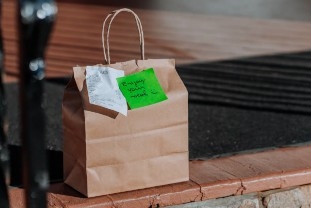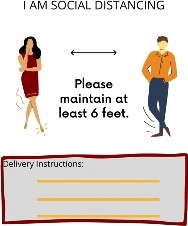Food Safety for Home Deliveries with Considerations for COVID-19 (Consumer Edition)
ID
FST-392NP
Introduction
There is currently no evidence to suggest that food or food packaging can transmit coronavirus 19 disease (COVID-19). Although transmission by food and food packaging is low, COVID-19 transmission is spread from human-to-human, or by contact with contaminated surfaces and transfer to mouth, nose, and eyes. Home delivery of food increased during the pandemic, as a way to reduce risks of infection. This guide describes best food safety practices for home deliveries with considerations for COVID-19 for consumers.
Although vaccines have been developed for COVID- 19, there is not enough information about the protection provided by these vaccines yet. The United States Centers for Disease Control and Prevention will make this decision based on vaccine efficacy, vaccination rate and community spread of virus. To learn more about the data available for the United States, visit: https://covid.cdc.gov/covid-data-tracker/-cases_casesper100klast7days.
Best Practices
Time and Temperature
- Foodborne microorganisms, such as bacteria like Salmonella, are not visible on foods. Relying on sensory cues such as taste, smell and sight will not prevent illness.
- Ensure hot foods and cold food are received at the appropriate temperature. Hot Food should be at or above 140°F. Cold Food should be at or below 40°F. Foods in the Danger Zone (40°F-140°F) may allow bacteria to grow in food within as little as 20 minutes.
- Throw away any perishable foods that were left at room temperature for more than 2 hours.
- Leftovers should be consumed within 3-5 days, if stored properly.
Tamper-Proof Packaging
- Did you know? More than 1 in 4 delivery drivers admit to eating consumers’ food (Matias, 2019).
- Before ordering, ask your restaurant how they ensure your delivered meal isn’t tampered with.
- Tampering with food during delivery can cause food safety risks (e.g., potential illness) through contamination.
- Restaurants can create a barrier to prevent tampering, such as providing bottled beverages instead of cups, using adhesive seals, or even staples to secure bags (Figure 1).

COVID-19 Considerations
Social Distancing
- Person to person transmission of COVID-19 is the biggest route of infection. If possible, pay for food orders ahead, and opt for contact-less delivery (Figure 1).
- People can still be ill without presenting any symptoms, so if contact-less delivery is not available or an option, keep at least 6 feet between you and the delivery person.
- Example Solutions to social distancing: 1. Homeowners can place painter’s tape at least 6 feet away from the door; or 2. Live in an apartment or other shared space: ask the delivery driver to place your food in your vehicle or other secured location while watching from a distance (Figure 2).

Wear Masks
- If you have to get within 6 feet of your delivery person, you and that individual should both wear masks.
- A mask protects your nose and mouth from saliva particles that can transmit COVID-19 during person-to-person contact.
- The US Centers for Disease Control and Prevention recommends a mask or facial covering with at least two layers that covers your nose and mouth, and secured under your chin.
Wash Hands or Use Sanitizer
- Wash your hands for at least 20 seconds with fresh water and soap before eating. See: https://www.facebook.com/VirginiaCooperativeExtension/videos/proper-handwashing-tips/195044264929141/ for the proper handwashing steps.
- If both are not available (fresh water and soap), and hands are not visibly dirty, a hand sanitizer with at least 60% alcohol may be used as an alternative. If hands are visibly dirty, hand sanitizer is not a suitable alternative, as the hand sanitizer solution will bind/attack organic matter (e.g., dirty, food debris) on hands, instead of germs.
References
US Department of Agriculture Food Safety and Inspection Service (FSIS). 2021. Danger Zone. Available at: https://www.fsis.usda.gov/food-safety/safe-food-handling-and-preparation/food- safety-basics/danger-zone-40f-140f.
Matias, Dani. 2019. 1 in 4 Food Delivery Drivers Admit to Eating your Food in National Public Radio (NPR). Available at: https://www.npr.org/2019/07/30/746600105/1-in-4-food-delivery-drivers-admit-to-eating-your-food.
Acknowledgments
This work was adapted from Chylsea Alexander’s Online Master’s Degree in Agricultural and Life Sciences project and report at Virginia Tech (2020).
Virginia Cooperative Extension materials are available for public use, reprint, or citation without further permission, provided the use includes credit to the author and to Virginia Cooperative Extension, Virginia Tech, and Virginia State University.
Virginia Cooperative Extension is a partnership of Virginia Tech, Virginia State University, the U.S. Department of Agriculture (USDA), and local governments, and is an equal opportunity employer. For the full non-discrimination statement, please visit ext.vt.edu/accessibility.
Publication Date
September 16, 2021



